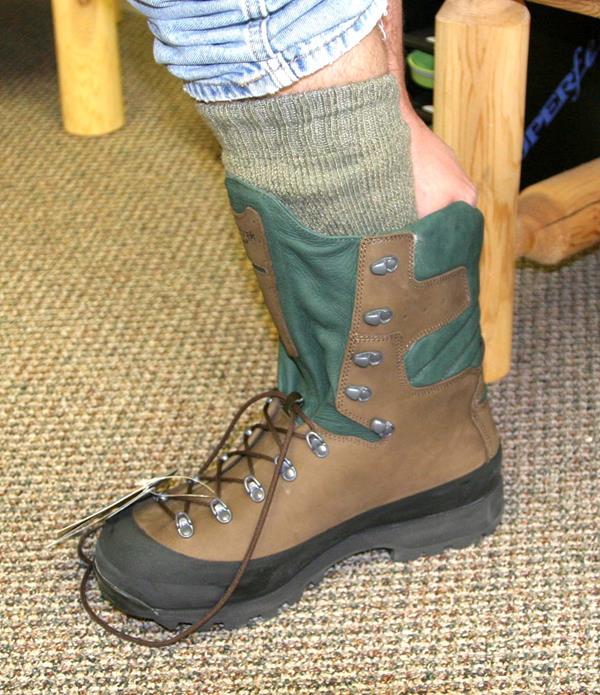
With hunting season just around the corner, now is the time to evaluate your old hunting boots and see if they can make it another year. Look for worn outsole tread, cracked leather, or worn stitching. Don’t wait too long to get your new boots, especially in the days of Covid- 19 where everything seems to be on backorder! If it is time for a new pair, definitely plan on spending as much time as possible breaking them in as well as conditioning your tender feet for your next hunting season.
Selecting the right new pair of hunting boots is an important part of your hunting preparation. You can get away with making an error on your other gear, but an error in your footwear selection and proper break-in can cost you a lot of pain and misery. Your feet are one of the slowest parts of your body to heal. You need to toughen them up, but do it carefully and gradually.
At your local sporting goods store, try to have your feet measured using the Brannock Measuring Device. The Brannock will measure your overall foot length, length of your arch, and foot width. Based on this size measurement, it is very common to round up to the next half size for your hunting boots. Once you purchase a pair of boots, it is important that you check for adequate toe length by sitting in a chair and putting the boots on but leaving them unlaced. Then slide your foot forward until any part of your toes just touch the end. Don’t smash them forward, just make light contact. Then check for at least a snug finger’s width behind your heel. This assures when the boots are laced snugly you will have adequate toe room in front of your toes. This is vital when going downhill with weight on your back. Once you have your boots, customize the fit by selecting a good quality wool blend sock that makes the fit of the boots nice and snug, not overly tight. Now you are ready for the break-in process.
Breaking in a boot is as much about conditioning your foot as it is getting the boot to shape to your foot. Good boots that will last you a thousand plus miles are going to be stiff out of the box. Sheep hunters and hard-core backcountry hunters know the benefit of stiff, supportive boots. They keep you on your feet on those severe slopes where falling is not an option.
August is actually a little late for the break-in process, but there is still time to get the job done. Wear your boots on a daily basis for at least a few hours a day. If you have the ability to wear them all day long without causing major damage to your foot, do it. Once you start to get a hot spot on your foot, it is time to put on some other shoes. The new leather will gradually start to give in as it loosens up over time, but initially, it will be your foot that gives in. Put some mole skin or Compeed onto the tender area for your next outing and make sure the edges are trimmed very well. The patch will help minimize friction in the boot and protect your skin. Be sure you take the patch off occasionally and allow the tender area to get some air when you aren’t wearing your boots. Every day of wear will get your foot a little tougher and the boot a little more pliable. Once you can go for several miles at a time without issues, it is time to push yourself and your boots. Try to go for longer and longer hikes and vary the terrain. Make sure you add in some uphill, downhill, and sidehills when you can. One of the best areas to train your feet and balance is walking off-trail along rocky stream beds. To increase the benefit of your workouts, start adding a little bit more weight in your backpack. It is amazing how much harder it is to do your workouts with 40 pounds on your back! Make sure you take your mole skin or Compeed patches with you, and if you feel a hot spot coming on during this break-in period, make sure you protect the spot right away. Sweating, hot, wet feet will blister much more easily, so take an extra pair of socks and change them halfway through your hikes.
Once you have about 50 miles on your new boots, they should be pretty well conformed to your feet and flexing in all of the right places. Make sure you condition and take care of your boots according to the manufacturer’s recommendations as well. This ensures your broken-in boots will last you a long time.
After achieving a proper break-in for your boots, you’re ready for the next hunting adventure, but you need to stay prepared for any foot issues that come up on your hunt. Most mountain hunts will push us harder than any of our training hikes. We typically hunt longer in more rugged terrain, so make sure you have your mole skin or Compeed patches, extra socks, and anti-bacterial treatments in your pack. When you feel that hot spot coming on, be sure to treat it right away before it becomes a blister. Air your feet every day, keep them clean, and change those socks. Even the toughest hunters with broken-in boots can get blisters and hot spots, so expect it and be prepared so you can stay focused and enjoy your next mountain hunt to the fullest.